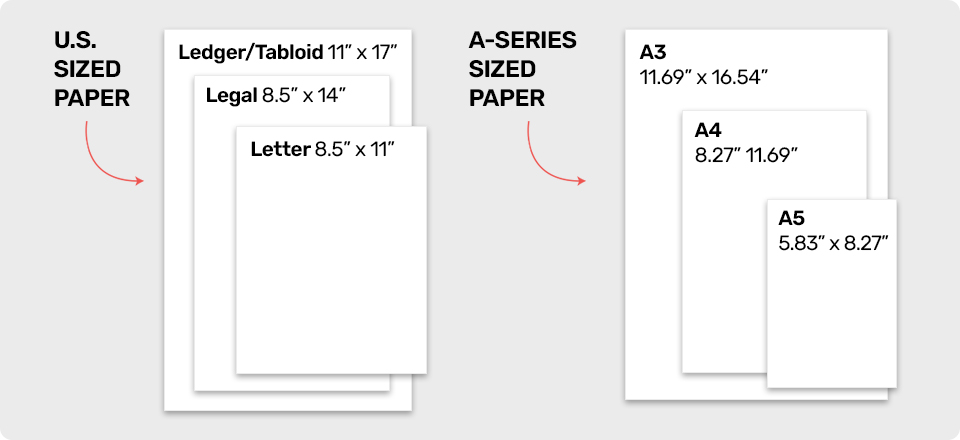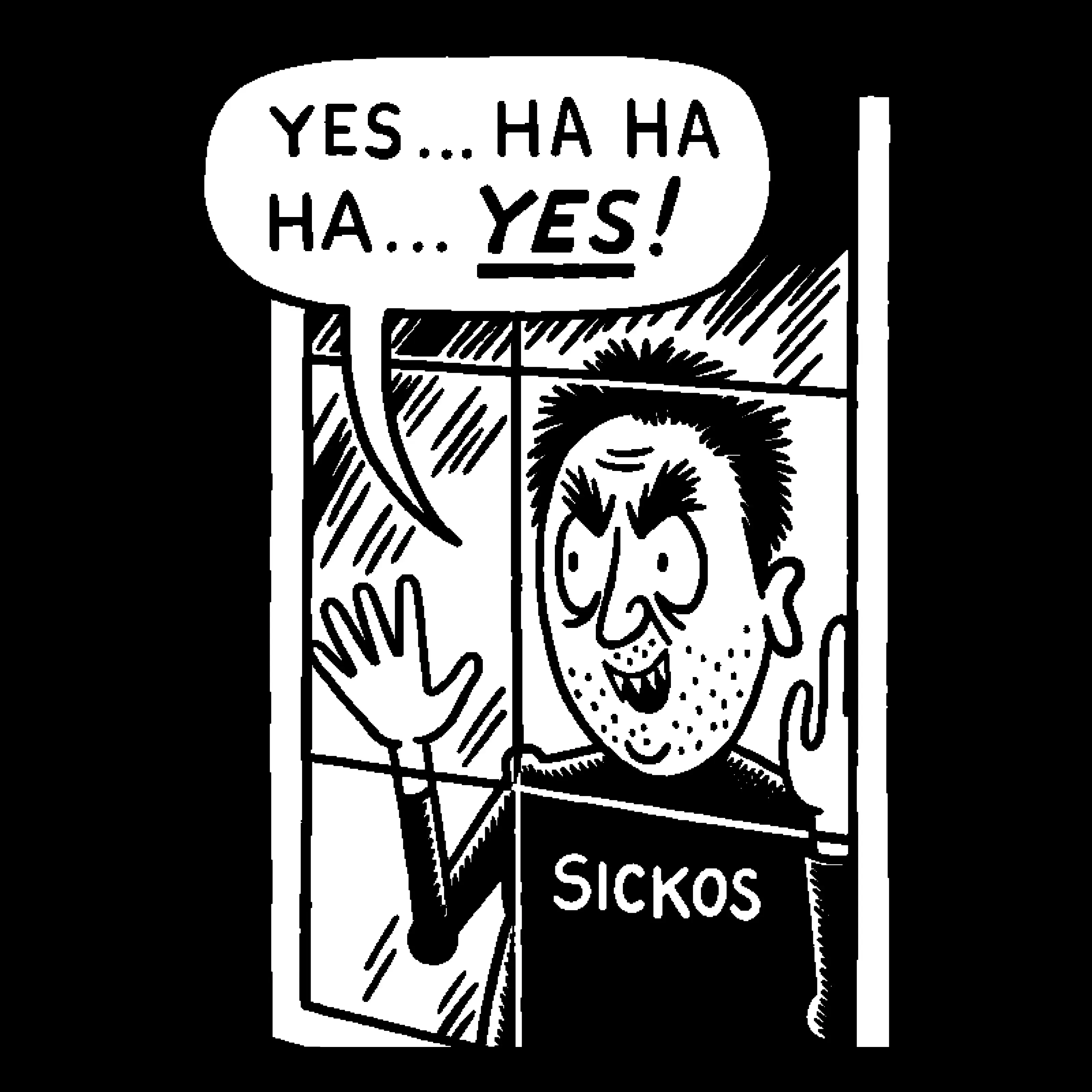alt-text
It blows our hivemind that the United States doesn’t use the ISO 216 paper size standard (A4, A5 and the gang).
Like, we consider ourselves worldly people and are aware of America’s little idiosyncrasies like mass incarceration, the widespread availability of assault weapons and not being able to transfer money via your banking app, but come on - look how absolutely great it is to be European:
The American mind cannot comprehend this diagram
[Diagram of paper sizes as listed below]
ISO 216 A series papers formats
AO
A1
A3
A5
A7
A6
Et.
A4
Instead, Americans prostrate themselves to bizarrely-named paper types of seemingly random size: Letter, Legal, Tabloid (Ledger) and all other types of sordid nonsense. We’re not even going to include a picture because this is a family-friendly finance blog.
Damn, you beat me to it.
Here is an alternative Piped link(s):
Piped is a privacy-respecting open-source alternative frontend to YouTube.
I’m open-source; check me out at GitHub.
The US also doesn’t officially use the metric system sigh.
Yes, yes we DO use the metric system officially. In the early 1970’s the metric system was made the official standard for weights and measures.
What we didn’t do was force everyone to use it at 3:11AM 11/21/1974. It was decided to take a longer approach and let the change happen naturally and it has happened.
Everything in the grocery store is marked with metric weights and volumes. We buy butter by the gram, soda pop by the liter and whisk(e)y buy the milliliter. And everyone is looking for that same missing 10mm socket/wrench. (Where does do those things go anyway?)
How much more metric do we really need to adopt?
deleted by creator
cars still measure speed in miles per gallon
The American system really is something huh
deleted by creator
The gallon of milk makes it incredibly easy to divide it into quarters. That makes it easy to simply double things - 2 pints = 1 quart. 2 quarts = 1/2 gallon. Two 1/2 gallons makes 1 gallon. This dates back to the days when you went to the market and told the seller that you want 1/2 or 1/4 of that container of whatever was in that container. Simple math for simple needs.
Your 1/4 of a pound of butter or one stick, (again simple divisions for a simple use), is marked with rough marks of tablespoons for cooking if you are using such measurements. But you are quite free to ignore them if you are using a scale. Not really any issue.
Yes, in the US travel distances are measured in miles. But that slowly becoming meaningless also. People, (no matter the units used to measure the psychical distance), care more about “how long does it take to get there” rather than the actual distance traveled. But, you are free to push a button and switch to kilometers if you choose.
Measuring height and weight in feet and inches and pounds is pretty much the only thing the medical system uses US Customary for. And I can’t imagine the sheer number of man hours and cost it would take to go back and convert all those medical records to centimeters and kilos. Somethings are just not worth the effort and cost for a minor data point that only matters only as a long term trend. (just like a single blood pressure is a meaningless data point but over a year may reveal a trend or not)
Each measurement system, US Customary or Metric, has it’s own advantages and disadvantages. To think one is better than the other is a chauvinism based on what you are most familiar with and nothing more.
The gallon of milk makes it incredibly easy to divide it into quarters
How did you reach the conclusion that liters can’t be halved or quartered? You could call 250ml a ‘quart’ if you wanted to.
Metric butter also has markings on it.
Those medical records should be stored digital anyways, and then it’s a matter of a few man hours to tell the computer to convert them.
Each measurement system, US Customary or Metric, has it’s own advantages and disadvantages.
Imo metric can do everything US customary can, but not the other way around, because it’s missing the simple conversions. But that’s it. Everything else is same same but different
I mean, a liter is very close to a quart, so it’s not like we’d be asking people to adjust their mindset completely. And ditching US measures means we could finally, once and for all, dispense with the nonsense of having a dry and a wet “cup” measure.
As for converting records, well, it would be trivial to display a converted value in whatever EMR system a practice uses while noting the values are converted and allowing display of the uncoverted data for validation. (Which brings us to the EMR discussion.)
The 10s are being held hostage by the 12.5/48.78 wrenches
There must be some invisible 10mm black hole just vacuuming up all the 10mm sockets and wrenches in the world. I can’t even tell you how many damn 10mm sockets and wrenches I’ve bought and I still only have one of each. Probably none. I haven’t needed to wrench anything in a couple weeks.
It’s probably part of the great filter.
It also goggles up tape measures.
deleted by creator
That was just ONE aspect of the adoption of the metric system. And that was done to make backwards compatibility easier because of long lasting legacy systems. Because some systems, like say plumbing in a home or city, last for a very long time before they get replaced or repaired. New plumbing installations often use Tubing like PEX which is metric. I designed and fabricated a dozen brackets for a US customer over the weekend for delivery today. They were made using millimeters as specified.
And if you actually pay attention to how the metric systems compares to the US customary, you would see just how closely they are related from the start. Which makes sense since what we call Imperial measurements predate the metric system by several hundred years.
Imperial is actually just a couple years older than US customary, it was predated by the “English units”.
Plumbing is still described in customary in Europe. You have 1/2 or 3/4 fittings etc.
America got someone triggered over paper.
Shooting ourselves in the face to own the mets
Eh, letter’s height to width ratio looks better.
Wait, the US genuinely doesn’t use A4 etc.?
Letter paper (8.5" x 11" | 215.9mm x 279.4mm) is kinda sorta pretty close to A4 (8.27" x 11.69" | 210mm x 297mm) so without having the two next to each other, it can seem like A4 is just a funny piece of letter, and vice versa. But to answer the actual question, USA and Canada (and apparently thr phillipines???) use the “North American Standard” which is a terrifying mess in comparison to the beauty that is the ISO standard.
I think Mexico too, or at least the paper name is “carta” and “oficio” which would translate to letter and legal (kinda)
Philippines makes sense, being a former US colony
The US is a former British colony, but it doesn’t stop them from doing whatever the hell they want. Utter lunatics…
I’m sorry, I still haven’t forgiven them for the whole tea thing…
We wanted to make sure it was as salty as King George III.
Tbf, I can see the use case for some “non-standard” sizes, like Legal, where having more height to the page without the extra width might be useful for readability of long documents.
…can’t think of an excuse for the rest, though.
As a European, I do appreciate Legal as a format.
It just happens slightly too often that an A4 is not long enough and the last bit, including the signature, goes to the next page.
I wish Legal was common here. Or perhaps we could get a Long A4 with a third extra height or so.
The Letter format should just be replaced by A4 though.
As a European, haven’t you heard about the existence of the B and C series of paper sizes? It may not be exactly what you have in mind, but B4 paper is 250 x 353 mm (9.8 x 13.9 in) and C4 paper is 229 x 324 mm (9 x 12.8 in). There’s also elongated A which is really long.
I hope you appreciate the irony of an American telling you about them.
Burn the unbeliever!
There’s also scrolls, if Elongated A isn’t quite enough.
I do miss the continuous form paper used with dot matrix printers.
It made banners easy, and I could make snakes out of the edges.
Tried these but my printer always gets caught on the wooden handle things 😜🤪
Time to update to a fax machine then!
https://www.possupply.com/other-pos-supplies-accessories/fax-paper-rolls-ribbons
That’s how it starts, you see the usefulness of one case, the next thing you know is you’re measuring distance in sheep and power in mice
power in mice
Hamsters, not mice. Get it right.
Their hole puncher has three holes and binders/folders have 3 rings as well
How many have yours got? More or fewer?
I have seen legal/letter sized clipboard with two rings, for the short end of the paper.
Either two or four. The two holes are kinda in the middle then if it’s four holes it’s those same two plus two more closer to the edge
And for 4, the spacing between them is the same as for the 2, leaving you 3 equal spaces.
TIL
And then there is Sweden…
6-9 holes? Is that where Swedes keep their meatballs
Filofax If from UK. For these organisers and notebooks they produce, imho it actually makes sense to have several (equally spaced) holes.
Swedish Triohålning and especially the corresponding binders however, are mildly speaking impractical: It works starting from ISO A6 instead A7 and reading documents in a trio binder is a mess.
YouTube content opportunity ❕
Comparison of US, EU, & Swedish hole punched paper. Which flips smoothest? Which is most tear resistant? Which tears most gracefully?
When have you ever seen a content gap on YouTube…
2, 4 or 23.
No, we mostly use Letter, Legal, etc. When you use photoshop to print, you would pick letter or legal usually.
https://goodcalculators.com/paper-size-conversion-calculator/
11x17 is incredibly common too. Usually it is oriented landscape and z folded to get a large diagram into a document. It’s kind of irritating that the most typical large format size is 24x36, which is a different aspect ratio than 11x17, for a variety of reasons. If you’re designing something you need to know what aspect ratio to design for. Most copiers can do 11x17, and if the standard large format size was 22x34 it would be exceedingly easy for most offices to produce good working copies of large documents. Best compromise I’ve seen is when people put a logo or header on the side that can be omitted when you switch aspect ratios.
We have trouble fitting all our freedom on your kooky, internationally-recognized sizes
Here’s a comparison using the most sensible units possible:

Ngl as a Canadian, I implicitly thought 8.5x11 was A4. Well that’s dumb, we should switch.
I’m British and you are not alone, worse still, I spent a year in the USA and never even noticed.
Also, I’m pretty sure A4 runs through an American printer just fine.
They jam less
Most printers support a variety of paper sizes
Do you have a moment to talk about 8.5 x 11?
Make it quick there’s an important call coming in about my auto insurance
Just ask them to fax you
Not-super-fun fact: an 8.5 x 11 inch paper can be useful if you lack a ruler in an American office & you need to measure an inch or a foot.
If you fold the paper like in an image I’ll try to attach, the hypotenuse is 12.01 inches.
Edit: then you fold the 12.01 inch side against the 11 inch side to get a 1.01 inch measurement
Not exact, but good enough if you need to know your neck size to buy a fancy shirt online - not that I would ever waste my corporation’s time that way!

Oh no, it’s getting worse!
How does that work? 8.5^2 + 11^2 is 193.25, square root of that is 13.9. Where does 12.01 come from?
Huh. . That’s weird. I could swear I double checked my math before I posted this One Dumb Trick online years and years ago…
Found the mistake, I had skipped a step, updated original post
Oh, that makes a lot more sense now.
Oh, that’s simple and useful.
Not-super-fun fact: you can measure in metric with school notebook paper.

Each sqare is 0.5 by 0.5 mm.
I use it a lot if i need to draw something that is x long. If you do a lot of graphs for example you can use the measurements on your ruler.
Correcting myself: 0.5 cm, not mm.
For graphs you can use graph paper with 1 mm grid.

I love how that OP’s solution requires an inexact technique to achieve an even less exact measurement. Like Americans really out here being proud of the stupidest shit
Tiny nitpick: I think you meant 0.5 by 0.5 cm (or 5 by 5 mm).
Yes, sorry. You are correct
Also there is coordinate paper:

1 by 1 mm.
And most people here know that an A4 is 21 (exactly) by 30 (roughly) cm, which you can use (surprisingly) use for measurement aswell.
21x29.7
This number is permanently stored in my memory, just like 1€ = 6.55957F
Not only that, if you know your A4, you can do all paper sizes in you head: A3 has A4’s long side as it’s short side, and A4’s short side x2 for it’s long side. Rinse and repeat.
I didn’t know Euro and Farad were related :O
What a nightmare
Not exact
The motto of the whole imperial unit system.
Is this why my printer has wierd size “letter”, that is not sized like letter?
Yeah, US software always defaults to their own non-compliant standards instead of looking at the location and determining the default that way.
That is why we in Europe and all the other parts of the world get these strange fuzzy prints where the text is almost unreadable, and is cut off on strange parts in the text.
This sounds like our bad, sorry.
My country (not USA) uses American paper. I hate it.
Do Euro printers say PC LOAD A4?
I think they probably do.
I want to only briefly defend the NA system in terms of naming. I get it, I worked in printing for decades, I know how shitty it all can be. But Letter and Tabloid communicate well for something that is otherwise all the fault of press guys.
yes, thats why i always was confused when i heared people online talk about pc load letter.
i kinda assumed it was just an odd way to refer to paper that some manufacturers used
Well, one still could do it like how many countries transitioned to the metric system: slap the traditional names onto things that are actually now defined by the metric system, like how China’s catty, about 0.60478… kg, became 0.5kg. Just slap “Letter” onto A4.
That’s going to make some driver developers very upset. And sensors in printer cartridges that can sense both A4 and Letter.
I say we just balls the whole thing. Screen or pencils.
For technical purposes that need to handle both you can just disambiguate it with “Letter (new)” and “Letter (work or school)”
Is that a subtle dig at Microsoft and their 5 billion different versions of Teams?
Well, it’s 2024, so they mostly say things like “out of A4 paper - load A4 paper in tray number 3”. But yeah, they used to.
Interesting, no photos of that message come up.
TBF, I only remember messages about “out of paper” or “all trays are empty”. Why specify paper size if the printer accepts different ones, anyway?
You really think people are too dumb to remember 2 letter codes that are literally printed on everything? Come on man :D
I am just grateful paper isn’t measured in hands
To be fair, A4 yields unwieldy pages that are too long to comfortably read. And when do you ever need the feature to fold an A4 sheet into A5?
Are you american? If so, the “unwieldy and too long” is probably because you’re not used to it. I’m not used to letter-size and it seems weirdly short and unnecessarily wide but I know it’s because I’m just not used to it.
I’m German. If the pages are a comfortable size, why does no publisher ever use A5 or A4 paper? To quote an answer I gave to another comment here:
Let’s check. I grabbed four random German books from my bookshelf. If you’re right, the pages should either be roughly 30cm×21cm (A4) or 15cm×10.5cm (A5).
Book 1: 18cm × 11.5; book 2: 19cm×12.5cm; book 3: 20.5cm × 12.5cm; book 4: 24cm × 17cm. None of those conform to the standard.
Another hint that the paper format is weird is that scientific papers on A4 are always either printed in two columns or use the ninths rule for margins, i.e. 1/9 of margin on the inner and upper edges and 2/9 of margin on the outer and bottom edges, essentially throwing away almost half of the page (I’ll admit there are more economic recommendations of 1/11 or 1/13). This is to make the columns narrower to get closer to the target of 60–80 characters per line. Note also that this makes the ‘usable’ area approximately 20cm long, which is much closer to the American’s ‘Legal’ format (216mm).
Let’s check. I grabbed four random German books from my bookshelf. If you’re right, the pages should either be roughly 30cm×21cm (A4) or 15cm×10.5cm (A5).
Book 1: 18cm × 11.5; book 2: 19cm×12.5cm; book 3: 20.5cm × 12.5cm; book 4: 24cm × 17cm. None of those conform to the standard.
A5 is not 15x10,5
If A4 is 291x210 then OBVIOUSLY the next one starts with 210: 210x148.
You’re right. Sorry for getting my post-7pm arithmetic skills on you. However, my point still stands. ‘Close’ is not ‘conforming’ to the standard.
These are very valid arguments that can’t be reduced to a lack of habit. Thanks for sharing your perspective!
And when do you ever need the feature to fold an A4 sheet into A5?
When you want to read it more comfortably for example.
A4 is 17.6mm longer than an 8.5x11" sheet of paper.
And when do you ever need the feature to fold an A4 sheet into A5?
I’m sold, we should botch all other formats for origami
I use the “A5 booklet” function all the time.
I do this all the time. I print two pages on one A4 sheet (or rather four, two on each side) and then fold them so they are like a leaflet.
That’s the main advantage of the system – you don’t have to design things differently depending on how big you want to print them. You can scale the same design to an A6 flyer or an A2 Poster.
almost all consumer printers are for a4.
i had (rare) occasions where i wanted to print a picture for an a3 sized frame and was able to glue together two a4 prints.also, as far as im aware, books in a4 size actually consist of a3 sheets bound together in the middle. (same with other sized books)
almost all consumer printers are for a4.
I never said A4 wasn’t the standard. I said it’s not a good one.
books in a4 size actually consist of a3 sheets bound together in the middle. (same with other sized books)
Let’s check. I grabbed four random German books from my bookshelf. If you’re right, the pages should either be roughly 30cm×21cm (A4) or 15cm×10.5cm (A5).
Book 1: 18cm × 11.5; book 2: 19cm×12.5cm; book 3: 20.5cm × 12.5cm; book 4: 24cm × 17cm. None of those conform to the standard.
Lmao, it does not.
Where I’m from, it’s super common to print A4 in half size and fold them into a little booklet when you need to distribute a few pages to loads of people
Skill issue
What the fuck, that was way more hilarious than a blog post about financial securities messaging ought to have been
TIL that there are different standards of paper sizes in other parts of the world. I never encountered this before despite living in Germany for 10 years, probably because the last time I was there was 30 years ago.
What NA does not do this what the fuck, backwards ass country in so many ways.
Right but this is definitely the most prominent & important reason
Wait a second if the bank app can’t transfer money how do they do it? Just barter with guns? Are the bullets like coins?
We involve third parties to help spy on our transactions.

It’s OK, they charge us for the privilege.

Wtf?
Also are banks just dumb or what? Has it crossed their greedy minds that they also can charge to make transfers?
What’s pictured there is when people use Venmo to pay for something instead of just transferring money between friends. The fee is paid by the seller. Banks already do this for traditional sellers in the US which is why you’ll see signs asking for cash instead of cards.
And tax evasion. But I don’t care as long as the tamales are good.
Do Visa, Mastercard, etc, not charge transaction fees in Europe? The only place I’ve been where there’s no transaction fees paid by the vendor is China.
I owned a business in Europe. My bank charged me a pretty low monthly flat fee for card charges, so I would take cards for any amount.
I’m in Australia and it’s a mix. Some places add the surcharge to the bill and can use cc for as low as$1, some don’t and don’t accept payments that’s less than 2 people’s meals ( and also don’t accept split bills).
But it’s very very hard to find a place that’s cash only. It comes to mind empanadas, so I got a laugh at the other reply about tamales.
We have a fee-free bank-to-bank transfer system that is based on pre-digital technology that takes 2-3 business days. We often call it “direct deposit” or automated clearing house (ACH). It’s often used for payroll and paying bills.
Now, we could probably make this payment system instantaneous relatively effortlessly (and thus useful for regular in-store purchases), but the banks lobby against this so they can continue to charge us fees and interest to over-use credit cards. (Interestingly enough, credit and debit cards all use direct deposit on the backend to actual transfer funds between parties).
This is all fine and dandy for most people because they simply can’t imagine doing things a more consumer-friendly way.
Your comment is all true, except - we CAN all imagine it, but as you pointed out, our unchecked hyper capitalism prevents it
We have a fee-free bank-to-bank transfer system that is based on pre-digital technology that takes 2-3 business days. We often call it “direct deposit” or automated clearing house (ACH).
Ah, right, kinda like SEPA Credit Transfer. You do need a persons IBAN which is a bit long, but their name is validated so you usually send it to the right person.
Now, we could probably make this payment system instantaneous relatively effortlessly
Ooh, cool, kinda like SEPA Instant Credit Transfer, which transfers money within ten seconds to bank accounts using the above mentioned number.
This is all fine and dandy for most people because they simply can’t imagine doing things a more consumer-friendly way
And that’s why, in the Netherlands, Tikkie took the country by storm. It is an app that allows you to use iDEAL (a web-based payment system, soon rolled out in Germany and Belgium as Vero) to send money to friends. Usually takes one pin and three taps to send it, and have it instantly appear on the account of the recipient.
I imagine it has also something to do with safety? Like, if it was instantaneous, that means you can do damage instantaneously, or a hacker might have fewer hurdles to go through.
Actually, a lot of banking apps can be used to transfer money now, it’s just done through Zelle. We can also do a bank transfer using the routing and account number (at least with my banking app) but that I think takes longer.
Venmo, Zelle, Cash app, etc.
My last 3 banks all had ACH transfers in-app, too, so idk what they’re smoking
ACH transfer to a friend’s bank account?
I assume it’s ACH, I’m at work and my job includes doing ACH work so that just kinda typed out.
It has me put their routing and account number in, then took anywhere from 5 minutes to a day to clear, p sure that’s ACH
Wow awesome!
A day isn’t cool, but five minutes is pretty much acceptable.
I’m in Aus and our transfers are usually instant. However if you’re transferring a couple hundred bucks or more, and you haven’t made a transfer before to a person, it will hold it for a day. I think to give the customer time to call and say the transfer was fraudulent.
I respect that!
I pay monthly rent in Australia with that, couple thousands and no big deal
And the ACH only takes three business days!
3 days? UK here, the other day I transferred money to my wife (different bank) while she was handing her card to the cashier at the supermarket. It took about 1 second.
Surely there’s some challenger bank letting you do modern stuff?
Hahaha! We don’t have fair competition in America, silly!
Yeah they’re just making shit up, and it’s anti American so Lemmy assumes it’s true.
SEPA is not to take for granted.
Isn’t sepa the eu system?
Sorry but bank transfers are not 1st world exclusive, it’s common place in 3rd world as well.
i just assumed people used 3rd party services for ease of use or faster transactions, seems so wild that you’d not be able to send money using your bank to me
here it takes 1-2 business day for a free wire transfer from one bank account to another, and you can do it in your banking app or on the bank’s website. you just need to authenticate with your online pin code. you can also pay 1€ to get a <24h transfer
it’s honestly much better than using a third party service, since pretty much everyone has a bank account, and pays using a card tied to that account directly
Idk what all this talk is about - we have wire transfers in the US. I don’t need a third party to do it either, it’s exactly as you’ve described, I can do one through the bank’s app or on their website, and it’s free. It’s not as common though since the information required is: Name of the recipient’s account exactly as it is, account #, routing #, and exact name of the bank tied to the routing #. You can save that info though to make it easier to transfer the next time around - it’s very useful for close family and friends.
and it’s free
This is very uncommon in the US. Most major banks (I’m not aware of any exceptions) charge a fee for each outgoing wire transfer, usually $25-$30. Bank of America, Wells Fargo, Chase, and PNC for just a few examples I’m aware of, plus every credit union that has local branches in my area. Some of those banks even add a second fee at the recipient’s side for incoming wire transfer.
They often encourage customers to rely on third party services like Zelle instead for small transfers to friends and family. Many banks’ sites/apps can also handle transfers between two accounts that both belong to the same bank for free too.
Brasil enters the chat
No fees transfer takes seconds, as long as it’s not international. People use it for buying groceries, clothes or paying for whatever they buy in the middle of the street from other people who are not businesses. Confirmation of payment from receivers end is immediate with a push on your phone.
All sellers can produce a QR code including receiver address and price to be payed. All bank apps scan and pay seamlessly.
Russia enters the chat.
Same. It is done with National Payment System of Cards law, which people usually call “MIR cards”. It started as replacement system for visa and mastercard, but evolved into System of Fast Payments/Transactions.
You can use it in three ways: enter recepient’s card number, enter recepient’s phone number or use qr code.
Quite similar to India’s UPI system
In Canada we have Interact e-Transfer. Basically all the banks colluded to make a system that allows for instant money transfer between banks using email or phone number as the recipient identifier, along with options for comments and security questions.
I felt like this was a huge step up compared to all the hoops and third party apps I had to use in Europe.
huh, yeah, i heard of similar things in the US
here it seems to be worked out through legislation though, rather than private deals, but that means it’s much slower to get set in place

























